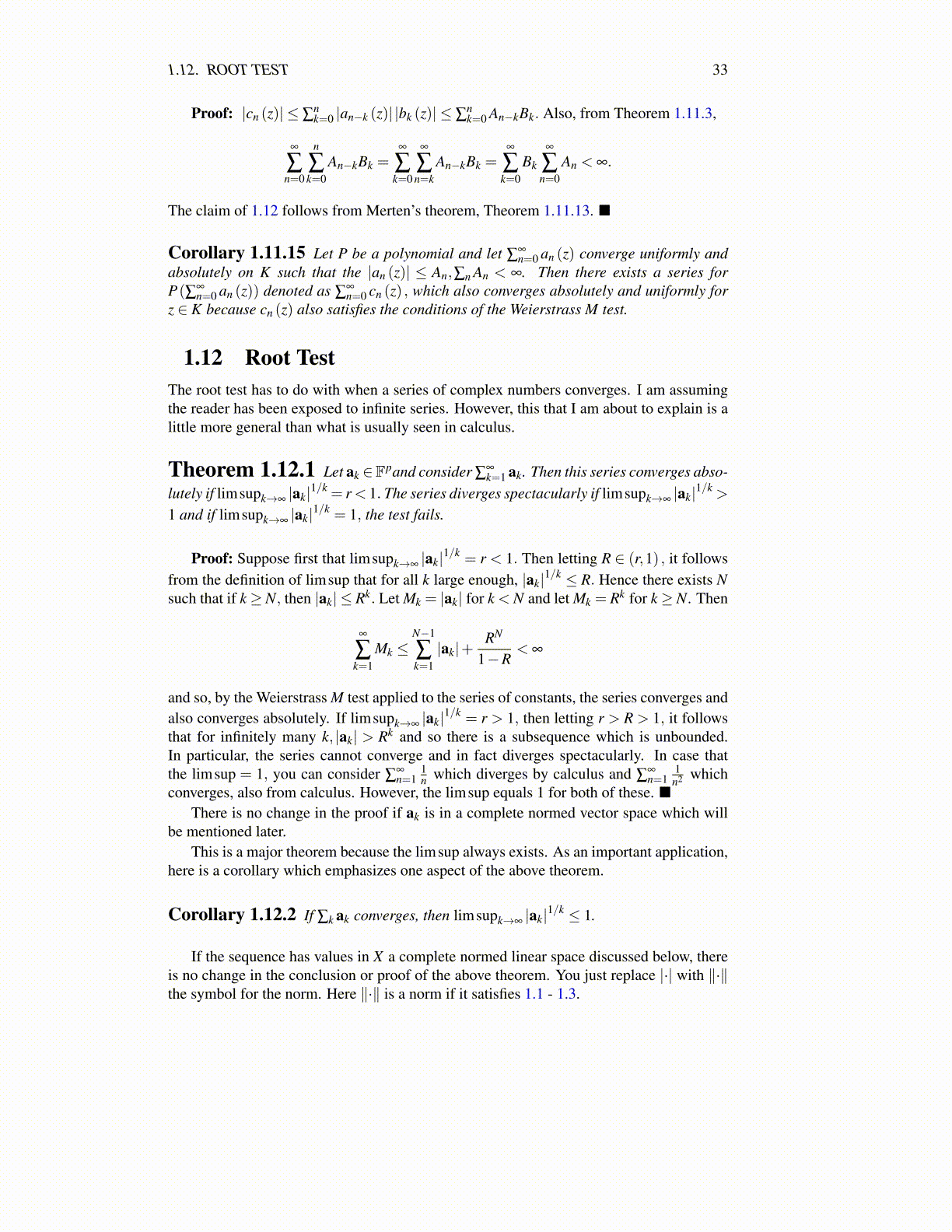
1.12. ROOT TEST 33
Proof: |cn (z)| ≤ ∑nk=0 |an−k (z)| |bk (z)| ≤ ∑
nk=0 An−kBk. Also, from Theorem 1.11.3,
∞
∑n=0
n
∑k=0
An−kBk =∞
∑k=0
∞
∑n=k
An−kBk =∞
∑k=0
Bk
∞
∑n=0
An < ∞.
The claim of 1.12 follows from Merten’s theorem, Theorem 1.11.13. ■
Corollary 1.11.15 Let P be a polynomial and let ∑∞n=0 an (z) converge uniformly and
absolutely on K such that the |an (z)| ≤ An,∑n An < ∞. Then there exists a series forP(∑∞
n=0 an (z)) denoted as ∑∞n=0 cn (z) , which also converges absolutely and uniformly for
z ∈ K because cn (z) also satisfies the conditions of the Weierstrass M test.
1.12 Root TestThe root test has to do with when a series of complex numbers converges. I am assumingthe reader has been exposed to infinite series. However, this that I am about to explain is alittle more general than what is usually seen in calculus.
Theorem 1.12.1 Let ak ∈Fpand consider ∑∞k=1 ak. Then this series converges abso-
lutely if limsupk→∞ |ak|1/k = r < 1. The series diverges spectacularly if limsupk→∞ |ak|1/k >
1 and if limsupk→∞ |ak|1/k = 1, the test fails.
Proof: Suppose first that limsupk→∞ |ak|1/k = r < 1. Then letting R ∈ (r,1) , it followsfrom the definition of limsup that for all k large enough, |ak|1/k ≤ R. Hence there exists Nsuch that if k≥ N, then |ak| ≤ Rk. Let Mk = |ak| for k < N and let Mk = Rk for k≥ N. Then
∞
∑k=1
Mk ≤N−1
∑k=1|ak|+
RN
1−R< ∞
and so, by the Weierstrass M test applied to the series of constants, the series converges andalso converges absolutely. If limsupk→∞ |ak|1/k = r > 1, then letting r > R > 1, it followsthat for infinitely many k, |ak| > Rk and so there is a subsequence which is unbounded.In particular, the series cannot converge and in fact diverges spectacularly. In case thatthe limsup = 1, you can consider ∑
∞n=1
1n which diverges by calculus and ∑
∞n=1
1n2 which
converges, also from calculus. However, the limsup equals 1 for both of these. ■There is no change in the proof if ak is in a complete normed vector space which will
be mentioned later.This is a major theorem because the limsup always exists. As an important application,
here is a corollary which emphasizes one aspect of the above theorem.
Corollary 1.12.2 If ∑k ak converges, then limsupk→∞ |ak|1/k ≤ 1.
If the sequence has values in X a complete normed linear space discussed below, thereis no change in the conclusion or proof of the above theorem. You just replace |·| with ∥·∥the symbol for the norm. Here ∥·∥ is a norm if it satisfies 1.1 - 1.3.